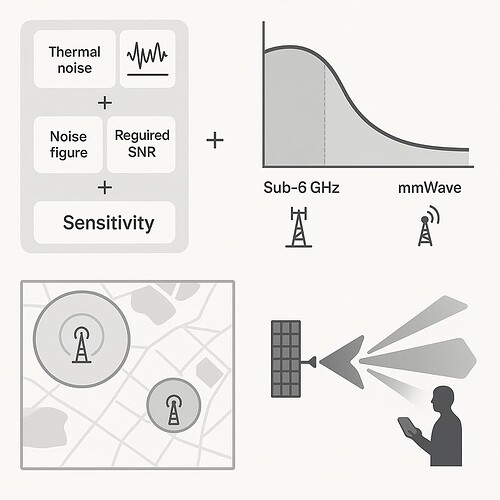In wireless systems, receiver sensitivity refers to the minimum signal level a receiver can detect and still decode data. It is essential to overall system performance, especially in 5G, which operates across Sub-6 GHz and mmWave frequencies. Each range has different propagation and design tradeoffs that affect sensitivity.
What Is Receiver Sensitivity
Receiver sensitivity is measured in dBm and calculated as:
Sensitivity = Thermal Noise + Noise Figure + Required SNR
Thermal noise depends on bandwidth (BW) and is given by -174 dBm/Hz plus 10 log10 (BW).
The noise figure accounts for hardware imperfections in the receiver.
Required signal-to-noise ratio (SNR) depends on the modulation and coding scheme.
Sub-6 GHz Receiver Sensitivity
Sub-6 GHz includes bands like n78 and n41 and is favored for wide coverage and indoor penetration. Sensitivity values here typically range from -100 to -120 dBm. For example, using a 20 MHz bandwidth with QPSK, 3GPP TS 38.101-1 shows sensitivity around -103 dBm assuming a 5 dB noise figure and a 2 dB SNR. Narrower channels and simpler modulation improve sensitivity.
These lower frequencies benefit from reduced path loss and better hardware efficiency.
mmWave Receiver Sensitivity
mmWave covers frequencies above 24 GHz, such as bands n258 and n260. These allow large bandwidths, up to 400 MHz, but suffer from high path loss and limited penetration. Receiver sensitivity is worse here, typically around -85 to -90 dBm.
For example, in 3GPP TS 38.101-2, a 400 MHz QPSK system at 28 GHz may have sensitivity around -87 dBm. This is due to higher thermal noise from wide bandwidth and a higher noise figure in mmWave front ends.
Beamforming and antenna arrays are used to direct energy and maintain link quality. mmWave systems often achieve beamforming gains of 20 to 30 dB, depending on antenna size and directionality. Sub-6 GHz systems typically achieve 3 to 6 dB BF gain on the UE and 10 to 12 dB on the base station.
Range Considerations
Sub-6 GHz supports wide-area coverage and mobility, with typical cell ranges from 500 meters up to 5 kilometers. In contrast, mmWave range is between 100 and 300 meters outdoors with line of sight (LOS), and much shorter in indoor or obstructed environments. This makes mmWave ideal for high-throughput small-cell applications, not broad coverage.
Testing and Design
3GPP standards define minimum sensitivity using BLER thresholds. The typical target is under 10 percent block error rate (BLER). Target SNR is derived from that. Downlink and uplink sensitivity are tested separately. In uplink, user equipment power and antenna gain are lower, making it the limiting factor (bottleneck) in many scenarios.
Conclusion
Receiver sensitivity is shaped by thermal noise, hardware noise, and required SNR. Sub-6 GHz offers better sensitivity and wide-area performance. mmWave enables ultra-fast data over short distances using directional antennas.
LinkedIn: ![]()
